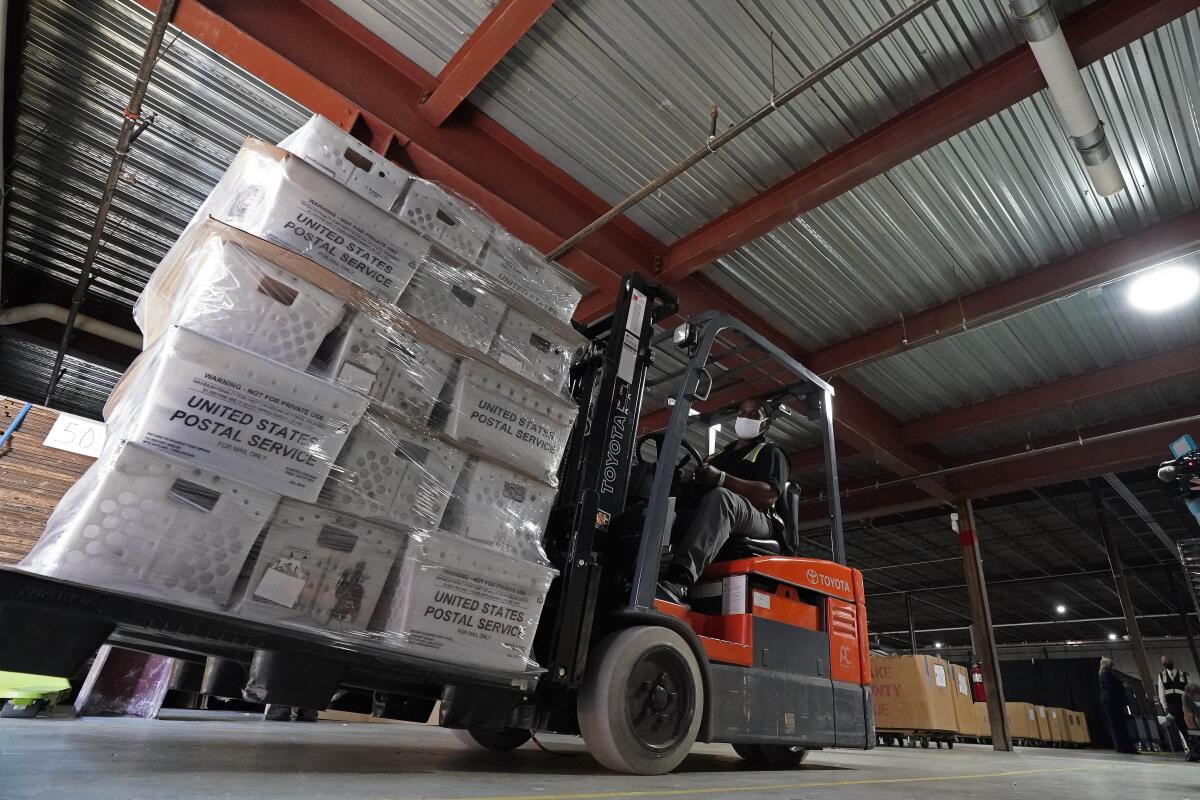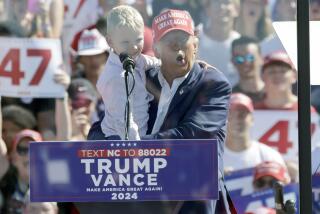Early North Carolina numbers show that mail voting is set to soar this election

- Share via
RALEIGH, N.C. — Mail balloting is set to begin Friday in the presidential election as North Carolina starts sending out more than 600,000 ballots to voters — responding to a massive spike in requests that has played out across the country as voters look for a safer way to cast ballots during the COVID-19 pandemic.
The 643,000 ballots requested in the initial wave in North Carolina were more than 16 times the number the state sent out at the same time four years ago. The requests came overwhelmingly from Democratic and independent voters, a reflection of a new partisan divide over mail voting.
The North Carolina numbers are one more bit of evidence of what experts have been predicting for months: that coronavirus concerns are likely to push tens of millions of voters to cast ballots by mail for the first time, transforming the way the election is conducted and the vote is counted.
In 2016, just one-quarter of the electorate cast votes by mail. This time, election officials expect the majority of voters to use the method. Wisconsin has already received nearly 100,000 more requests than it did in the 2016 election. In Florida, 3,347,960 people requested ballots during the 2016 election. The state has already received 4,270,781 requests.
While ballots go out in two weeks in other battleground states such as Minnesota, Pennsylvania and Wisconsin, all eyes are on North Carolina as it leads off.
Wake County, which includes the capital city of Raleigh, accounts for more than 100,000 absentee ballot requests so far. This week, the office groaned under the twin stresses of record mail voting and the pandemic.
North Carolina is a key state as Democrats try to redraw the political map. The state is trending blue, but it has disappointed them before.
On Thursday, workers in yellow vests and masks sat at folding tables spaced apart in a county warehouse, affixing address labels to envelopes and then putting the ballots inside. Board of Elections Director Gary Sims said that the pandemic presents new challenges for the workers, who are using hand sanitizer as much as possible.
“We’re already at over three times the amount of requests that we’ve ever had in its entirety in an election. So that’s caused us to change some of our business processes,” Sims said.
The increase in interest has come with an increase in partisan division.
The GOP has historically dominated North Carolina mail voting, but this year the people asking for the ballots are generally not Republicans. Democrats requested more than 337,000 ballots, and independents 200,000, while only 103,000 were sought by Republicans. Voters in the state can continue to request the ballots up until Oct. 27, though that may be too close to the Nov. 3 election for them to receive the ballot and return it to their local elections office in time.
The judges ruled that voters had a strong likelihood of winning a lawsuit that argued Republicans unlawfully manipulated district lines for partisan gain.
The Democratic lead in mail ballots isn’t only in North Carolina. In Maine, 60% of requests for mail ballots have been made by Democrats and 22% by independents. In Pennsylvania, Democrats have requested nearly triple the number of absentee ballots as Republicans. In Florida, where the GOP once dominated mail voting, 47.5% of requests have come from Democrats and 32% from Republicans.
“These numbers are astronomical, and on top of that, there’s these clear partisan differences,” said Michael McDonald, a political scientist at the University of Florida who tracks early voting.

The party split comes as President Trump has baselessly criticized mail ballots as vulnerable to fraud, even as the Centers for Disease Control and Prevention recommended them as a safer alternative to in-person voting during the pandemic. The numbers in North Carolina and elsewhere suggest that Republicans are listening to Trump, shying away from mail ballots, while Democrats rush to use them.
The Democrats’ advantage in mail voting won’t necessarily translate into an advantage in the election, however. Ballots cast on election day, expected to be mostly Republican, will count just as much as those sent remotely.
Immanuel Jarvis, GOP chair in Durham, N.C., sees President Trump as a friend of Black Americans and the media as an enemy.
“Even if the Democrats build up a huge lead in the early vote ballot, I still need to see the election day votes, because that’s going to be that red wave,” McDonald said.
Tom Bonier, chief executive of the Democratic data firm Target Smart, agreed. But he’s seen one hopeful indicator for his party: 16% of the mail ballot requests so far have been from voters who didn’t vote in 2016. They’re also younger than typical mail voters.
“Seeing younger Democrats adapting to the technique is the first sign of a potential enthusiasm gap,” Bonier said, noting that it won’t be possible to know if the GOP catches up until election day.
Campaigns usually want their voters to cast ballots by mail because they can “bank” those early votes and focus their resources getting remaining supporters to the polls on election day. Trump has complicated that effort among Republicans by repeatedly condemning mail voting, even though, in the five states that routinely mail ballots to all voters, there has been no large-scale fraud.
Get our L.A. Times Politics newsletter
The latest news, analysis and insights from our politics team.
You may occasionally receive promotional content from the Los Angeles Times.
On Wednesday, while in North Carolina, Trump suggested that supporters vote once by mail and a second time in person to test whether the system could weed out voter fraud. The executive director of North Carolina’s board of elections, Karen Brinson Bell, on Thursday warned that voting twice in the state is a felony, as is trying to induce someone to vote twice.
Republicans have tried to overcome Trump’s open skepticism and persuade their own voters to use the absentee voting system. The North Carolina Republican Party, for example, has sent a series of mailers urging its voters to cast ballots through the system, accompanied by copies of Trump tweets with his criticism of mail voting edited out.
The message hasn’t gotten through to Nona Flythe, 64, an unaffiliated voter who lives in Southport, on the North Carolina coast. She plans to vote a straight Republican ticket — in person — this year.
“I just think I’m stuck in my ways,” Flythe said. “I’ve always done it that way, and I think if I socially distance and wear a mask that it’s fine.”
More to Read
Get the L.A. Times Politics newsletter
Deeply reported insights into legislation, politics and policy from Sacramento, Washington and beyond. In your inbox twice per week.
You may occasionally receive promotional content from the Los Angeles Times.









